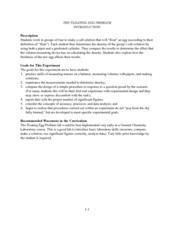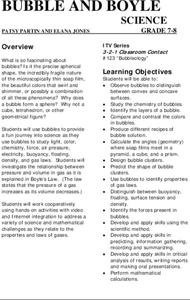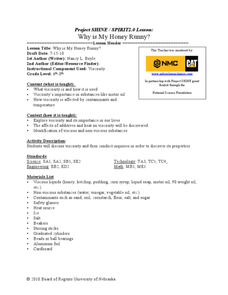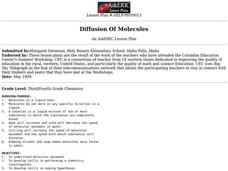Curated OER
Chemistry: Mini-Volcanoes
Pupils observe an experiment using common household chemicals to simulate a volcanic eruption. In small cups, they follow the teacher's instructions to make their own volcanoes. After watching a Brain-pop video, students complete...
Curated OER
Surface Tension (Soap Boat)
Students investigate the affect of soap and water temperature on surface tension.
Curated OER
Electrostatics
Students explore charges using balloons and soap bubbles. In this chemistry lesson plan, students analyze the Van de Graaf generator to see how charges flow using charged particles, static electricity and lighting. This assignment...
Curated OER
An Introduction to Acids and Bases
Students explore acids and bases. In this lesson about acids and bases, students do an experiment to test certain items to determine what they are. Students use cabbage and litmus paper as indicators. Students understand how to sort the...
Curated OER
The Floating Egg Problem
This is the grown-up version of the classic "float an egg in salt water" experience, plus an experiment in soap making. High schoolers explore density, but more importantly, practice accuracy, precision, and the use of significant...
Curated OER
Sour and Bitter: Acids and Bases
Tenth graders distinguish between acids and bases. In this pH lesson, 10th graders view a PowerPoint and discuss the characteristics of an acid and a base. They investigate natural substances to determine the pH level of each.
Curated OER
Bubble and Boyle
Even middle schoolers still enjoy experimenting with bubbles! They execute a series of experiments enabling them to distinguish between convex and concave surfaces, explore the properties of buoyancy, surface tension, and density,...
Curated OER
Silica Tetrahedron Model
Very simply, pairs of learners construct a model of the tetrahedral silica structure using raisins and toothpicks. They dip it into a soapy solution and then blow a bubble "atom" into its center. The lesson plan gives instructions that...
Curated OER
Bubble and Boyle
Middle-schoolers still enjoy playing with bubbles! In this series of eight laboratory activities, science learners explore convex and concave surfaces, angles, gas laws, buoyancy, density and more!
Curated OER
WS 8.9 Presentation Questions
In this mixtures worksheet, students answer twenty three questions about student presentations on topics such as amalgams, homogenized milk, antifreeze and coolants, soaps and detergents and water softeners.
Curated OER
Playing With Polymers
Students explore the world of polymers. In this chemistry instructional activity, students make polymers and observe their properties. Follow-up questions and extension activities are included.
Curated OER
Why is My Honey Runny?
Students identify the factors that affect viscosity of substances. In this chemistry lesson, students define what viscosity is in their own words. They give real world applications of viscosity.
Curated OER
Indicator Sponge A Discrepant Event Demonstration
Young scholars explore the use of acid and base pH indicators. The teacher saturates an indicator sponge with congo red solution. Afterwards, the sponge is placed in a blue base solution. Students observe that the blue sponge actually...
Curated OER
Water Hardness- Causes and Testing
Eighth graders examine what materials cause water hardness and the relative measure of water hardness in a two part lab activity. In part one, 8th graders add an assigned soap test solution to eleven different test tube solutions in...
Curated OER
Tie Dye
Students practice writing research proposals to test the color fastness of a dye once it has been exposed to a t-shirt. Each proposal needs details of experimental design, length of treatment, and means of cleaning the shirt. All...
Curated OER
Diffusion of Molecules
Students study the process for diffusion of molecules. In this chemistry lesson, students understand molecular movement, develop skills for a chemistry investigation, develop skills in making hypotheses, develop observational skills, and...
Curated OER
Where My Peeps At?
Students conduct a series of activity that demonstrates Charles' and Boyle's Law. In this chemistry lesson, students determine the relationship among pressure, volume and temperature. They solve problems using mathematical equation.
Curated OER
Diffusion of Molecules
Students conduct a series of experiments to observe factors that impact molecular movement. For this molecular chemistry lesson, students drop food coloring in water with different properties (hot, with ice, with alcohol) and observe how...
Curated OER
States of Matter
Students discuss a given set of questions based on Chemistry and matter and review a glossary of terms. They conduct experiments on each state of matter: "Dry ice and water, Dry ice and soap and Dry ice and Isopropyl Alcohol." and...
Curated OER
ENGINEERING TOOTHPASTE
Students make a class list of household products and discuss how many of these products are made through chemistry. They guess the ingredients in the products and imagine how toothpaste might be made. They make toothpaste.
Curated OER
Mole Relations
Tenth graders investigate the mole using raisins, sunflower seeds and M&Ms candy. For this mole relations lesson plan, 10th graders create trail mix packets using the food items given to them using "dozen" as the units. Students...
Curated OER
Making "Cents" of Surface Tension
Young scholars explore the unique behaviors of water. They investigate surface tension using water drops on a penny and pennies dropped in a cup.
Curated OER
The Chemistry of Fire and Other Oxidation Reactions
Learners explore the process of combustion.
Curated OER
Diffusion Of Molecules
Students investigate molecular movement while studying how to perform a chemistry investigation.

























